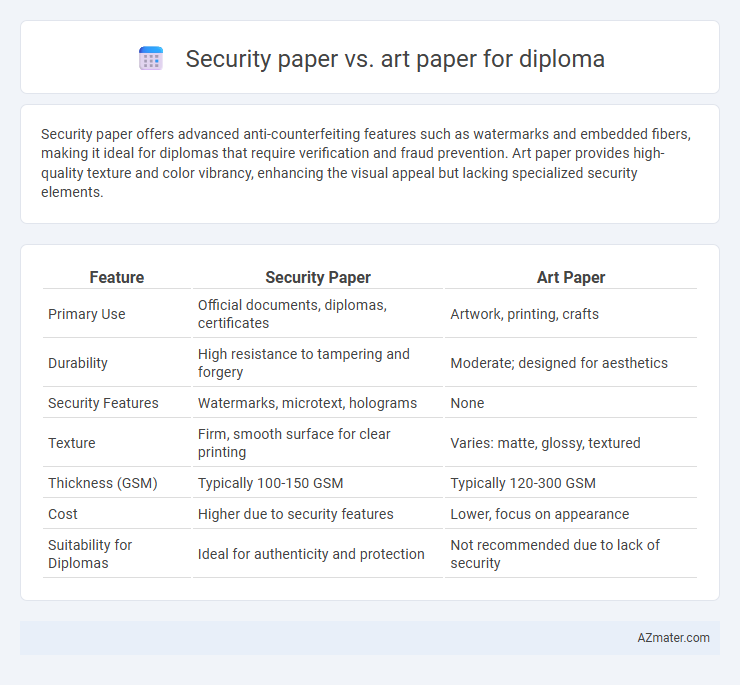Security paper offers advanced anti-counterfeiting features such as watermarks and embedded fibers, making it ideal for diplomas that require verification and fraud prevention. Art paper provides high-quality texture and color vibrancy, enhancing the visual appeal but lacking specialized security elements.
Table of Comparison
| Feature | Security Paper | Art Paper |
|---|---|---|
| Primary Use | Official documents, diplomas, certificates | Artwork, printing, crafts |
| Durability | High resistance to tampering and forgery | Moderate; designed for aesthetics |
| Security Features | Watermarks, microtext, holograms | None |
| Texture | Firm, smooth surface for clear printing | Varies: matte, glossy, textured |
| Thickness (GSM) | Typically 100-150 GSM | Typically 120-300 GSM |
| Cost | Higher due to security features | Lower, focus on appearance |
| Suitability for Diplomas | Ideal for authenticity and protection | Not recommended due to lack of security |
Introduction to Diploma Paper Types
Security paper, designed with embedded features such as watermarks and fibers to prevent forgery, is commonly used for official diploma certificates ensuring authenticity and tamper resistance. Art paper, characterized by a smooth, high-quality surface with excellent color reproduction, is often selected for diplomas that emphasize aesthetic appeal and presentation. Choosing between security paper and art paper depends on prioritizing fraud prevention or visual elegance in diploma production.
Understanding Security Paper
Security paper incorporates advanced features like watermarks, microtext, and UV-reactive fibers to prevent counterfeiting and unauthorized duplication, essential for safeguarding diplomas. Art paper, typically smoother and designed for aesthetic quality, lacks such protective elements, making it less suitable for official documents requiring authentication. Understanding the distinct characteristics of security paper ensures the integrity and credibility of diploma issuance.
What is Art Paper?
Art paper is a high-quality, smooth, and often glossy or matte paper primarily used for printing photographs, artwork, and high-resolution images due to its excellent color reproduction and sharp detail capacity. It is typically coated to enhance vibrancy and prevent ink bleed, making it ideal for diplomas that require visually appealing presentation with fine graphics or ornate designs. Compared to security paper, which is embedded with anti-counterfeit features like watermarks and fibers, art paper focuses on aesthetic appeal rather than security elements.
Key Features of Security Paper
Security paper is specifically designed with anti-counterfeiting features such as watermarks, microtext, and UV-reactive fibers, which provide enhanced protection against forgery and tampering. It is commonly used for diplomas to ensure authenticity and prevent unauthorized reproductions. Art paper, on the other hand, prioritizes texture and color vibrancy for aesthetic appeal but lacks the embedded security elements essential for official documents.
Art Paper Characteristics
Art paper features a smooth, heavy texture designed for high-quality printing, offering superior color reproduction and vibrant visual effects essential for diploma certificates. Its coated surface prevents ink bleeding, ensuring crisp, detailed images and text for a polished, professional appearance. Unlike security paper, which includes embedded anti-counterfeit features, art paper prioritizes aesthetic appeal and durability through its glossy or matte finishes.
Importance of Security in Diplomas
Security paper is crucial for diplomas as it incorporates anti-counterfeiting measures like watermarks, microprinting, and holograms, significantly reducing the risk of forgery. Art paper, while offering superior texture and visual appeal, lacks these embedded security features, making it less suitable for official documents requiring authentication. Employing specialized security paper ensures the diploma's integrity and credibility, protecting institutions and recipients from fraudulent claims.
Visual Impact and Print Quality
Security paper offers enhanced durability and distinctive features like watermarks and microprinting, improving visual impact by preventing counterfeiting in diploma production. Art paper provides superior print quality with vibrant colors and sharp details, ideal for showcasing intricate designs and seals on diplomas. Choosing between them depends on prioritizing anti-fraud measures or high-resolution aesthetics for diploma presentation.
Cost Comparison: Security vs Art Paper
Security paper typically costs significantly more than art paper due to specialized features like watermarks, security threads, and anti-counterfeit technology designed to prevent forgery. Art paper is generally more affordable since it focuses on texture, finish, and print quality for creative work rather than security elements. For diploma printing, investing in security paper ensures document authenticity, justifying the higher expense compared to standard art paper.
Durability and Longevity
Security paper offers superior durability and longevity compared to art paper due to its specialized fibers and embedded security features that resist tampering, moisture, and fading over time. Art paper, while excellent for high-quality printing and vibrant colors, generally lacks the robust composition required to withstand frequent handling or environmental stress. For diploma documents intended to last decades, security paper ensures better preservation and authenticity protection.
Choosing the Right Paper for Diplomas
Selecting the right paper for diplomas is essential for ensuring durability and professional appearance. Security paper offers enhanced protection with features like watermarks and tamper-evident designs, preventing forgery and unauthorized duplication. Art paper provides a high-quality, smooth finish ideal for vibrant prints and elegant presentations but lacks inherent security features, making security paper the preferred choice for official diplomas.

Infographic: Security paper vs Art paper for Diploma
 azmater.com
azmater.com